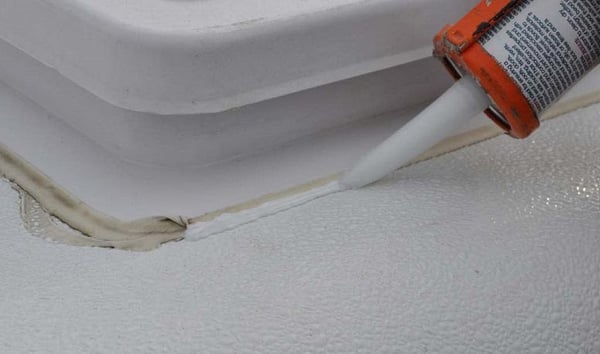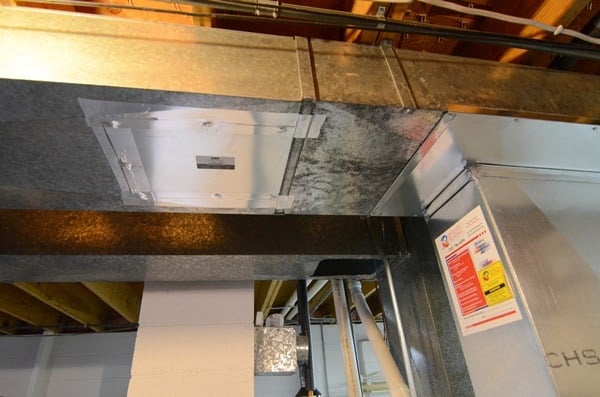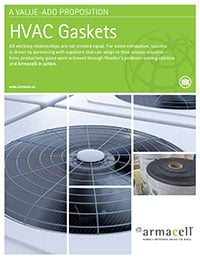.jpg?width=600&name=IMG_0821%20(1).jpg)
Frame gaskets are the first line of defense when it comes to keeping HVAC products secure. They work to seal out dust, debris, moisture, and other environmental factors, making them an essential component of any unit.
However, traditional die-cut frame gaskets are expensive for many manufacturers due to the wasted material that results from their creation. Alternative gasket types serve as a solution to this problem, which provides you with parts that cost less and perform the same as frame gaskets.
In this guide, the gasket experts at Mueller will break down everything you need to know about frame gaskets and their alternatives, and then provide tips for selection to set you up for gasketing success.
What Are Frame Gaskets and How Are They Used?
Frame gaskets (sometimes referred to as door gaskets) are seals used to fill open spaces between two mating surfaces in a number of applications. These gaskets have an open space in the center and are used around the perimeter of whatever surfaces they are applied to.
This type of gasket has a thin-to-medium wall that forms the frame and is used to prevent leakage into (or out of) areas where the mating surfaces are pressed together. Frame gaskets can be made of multiple materials, with the most common being sponges, solid rubbers, and silicones.
Frame gaskets are primarily used to keep dust, moisture, or other environmental concerns out of units. They’re used in the access panel doors, internal flaps, and throughout internal duct systems.
Frame gaskets are essential in many of these applications, especially for outdoor units. However, they are often expensive and drive up costs during the manufacturing process due to the material wasted by die-cutting out the center section of the material to make a frame.

What Are Some Alternatives to Frame Gaskets?
Luckily, there are multiple alternatives to frame gaskets that meet your customer’s specifications for their product (while reducing overall cost).
Collapsible Gaskets
Collapsible gaskets are among the most common substitutes for frame gaskets due to their almost identical functions. This gasket type is a frame gasket, but in a collapsed, folded state. This part looks like a regular rectangular strip with minor angular cuts that allow the end user to open the gasket and apply it to a component.
Collapsible gaskets are about half the cost of standard frame gaskets and match their performance almost exactly. However, there is more labor required for the end-user due to the collapsible gasket’s folded nature. Collapsible gaskets will snap back into place if the user lets go of them, making their application more involved than frame gaskets.
Dovetail Strips
Dovetail strips are like frame gaskets broken up into multiple sections, free for you to place however you like. This makes assembly easier for the end-user since the application of this gasket type simply involves attaching the two different dovetail ends together, almost like a puzzle.
Dovetail strips are just as cost-effective as collapsible gaskets due to their minimizing of wasted material. However, these gaskets may have small, open areas where the sections join each other, as they are made of multiple pieces and aren’t completely solid.
Molded Gaskets
Molded gaskets are almost identical to traditional die-cut frame gaskets. They can be made to fit any shape and have the added bonus of minimal material waste due to molding. This type of gasket may have a lower piece price as a result of the molding process, but typically has a higher upfront tooling cost due to the cost of the mold itself.
Room Temperature Vulcanizing (RTV) Silicone Caulk
The final common substitute for frame gaskets is RTV silicone caulk. This product is applied in the place of frame gaskets (usually by hand). RTV caulk is a low-cost option best used for low-volume applications; it is often messy and inconsistent if applied unevenly. It can be used in gasketing applications but is more suited for tasks like duct sealing.

How Do You Choose the Right Gasket Type for Your Application?
As with most material selection, your choice of gasket will depend on the application and the product’s environment. With frame gasket alternatives, all of the seal types discussed will perform similarly with the proper precautions.
For example, if you’re selecting a frame-type gasket for an access panel that needs to create a watertight seal, dovetail stripping may not be the best choice due to the open seams where the sections join each other. However, you can address this issue with the use of epoxy or glues. Similarly, you may not choose a collapsible gasket if you want to target installation labor costs.
Cost is often a deciding factor in your gasketing decision if you’re flexible with performance. Traditional, die-cut frame gaskets are the most expensive option available; collapsible and dovetail gaskets both cost approximately half the price per part. RTV caulk will be the cheapest, but also the most inconsistent. Molded gaskets will be similar in price to collapsible gaskets but feature a higher upfront cost.
Ask yourself the following question to help guide your gasket selection:
- What is the purpose of your frame gasket?
Once you’ve determined the gasket’s application, converters can guide you to the best options for your project, at the lowest price.

Why Does Choosing the Right Frame-Type Gasket Matter?
Deciding on a gasket for your next HVAC project is important for creating a great product. You want to get the best cost without sacrificing performance, which makes knowing your options essential.
By understanding the qualities and differences between frame gaskets and collapsible seals, dovetail gaskets, molded gaskets, and RTV silicone caulk, you can weigh all your options and make an informed decision.
While there is nothing wrong with using traditional die-cut frame gaskets, knowing that there are other options with similar performance (and a lower price point) helps save money for both you and your customer. Use this guide whenever you have to decide on a frame-type gasket, and you’ll find the right part for the job every time.






